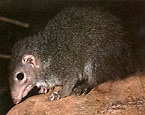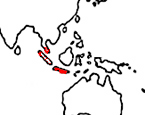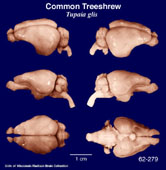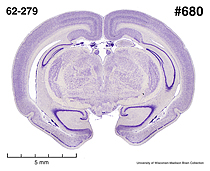|
Common Treeshrew
(Tupaia glis) #62-279 |
||||
|
|
Physical
characteristics and distribution
|
|
The
generic name derives from the Malaysian word "tupai" meaning
squirrel. The Treeshrew has a longer nose and no long black
whiskers like squirrels. It differs from other genera of
Treeshrews as it has a tail covered with long hairs, a squared
off patch of naked skin above the nose, and lower earlobe
which is smaller than the top of the ear. The head and body
length of tupai averages between 140 - 230 mm, and the tail
is a little more than the length of the head and body. Weights
range from 100-300 grams. Colors of the upper parts vary
from ochre, reddish, olive or shades of brown and gray to
almost black. Underparts are whitish to buff or dark brown.
And there is sometimes a light shoulder stripe. There is
a throat gland present in Tupaia glis which differs
from the glands in primates, but occurs in some insectivores.
|
|
Description
of the brain
|
|
Animal
source and preparation
|
|
All
specimens collected followed the same preparation
and histological procedure.
|
Other Related Resources (websites and publications)
List of Specimens | Explore Collections | Brain Sections | Brain Evolution | Brain Development | Brain Circuitry | Brain Functions | Location and Use | Related Web Sites | Contact Us | Search MSU Database | Personnel | Home



